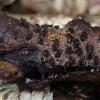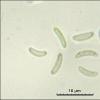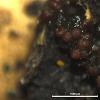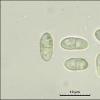
14-11-2025 16:26
 Marian Jagers
Marian Jagers
Hello everyone, On dead wood of Cytisus scoparius

14-11-2025 18:31
 Lothar Krieglsteiner
Lothar Krieglsteiner
Hello,can somebody provide me with a file of:Rothe

12-11-2025 09:25
 Viktorie Halasu
Viktorie Halasu
Hello, I need help with a pale terrestric Pseudom

11-11-2025 20:16
Bohan JiaHi, lastly I have found these tiny yellow decayin

09-11-2025 13:20
Hello.A tiny ascomycete, appearing as erupting gra

08-11-2025 00:29
 Francois Guay
Francois Guay
I found this species in Quebec, Canada, on herbace
Dialonectria on Diatrypella
Juuso Äikäs,
16-11-2022 19:57
Diatrypella spores:
(5) 5.6 - 6.2 (6.5) × (1.2) 1.24 - 1.7 µm
Q = (3.4) 3.41 - 4.6 (5.2) ; N = 10
Me = 5.9 × 1.5 µm ; Qe = 4
Dialonectria spores:
(7.6) 7.64 - 9.47 (9.5) × 3.9 - 4.2 µm
Q = 2 - 2.3 ; N = 5
Me = 8.6 × 4 µm ; Qe = 2.1
I suspect this might be a case of Dialonectria episphaeria growing on Diatrypella favacea, although the spores are maybe a bit small for both species.
Is this data enough to say anything with certainty, or are there other possibilities?
Andgelo Mombert,
17-11-2022 08:28

Re : Dialonectria on Diatrypella
Bonjour,
Dialonectria episphaeria ne pousse que sur Diatrype sp.
D'après moi, il s'agit ici d'un Stylonectria. Beaucoup des espèces de ce genre ne sont pas spécifiques à un hôte et il n'est pas possible de les identifier sans culture.
Dialonectria episphaeria ne pousse que sur Diatrype sp.
D'après moi, il s'agit ici d'un Stylonectria. Beaucoup des espèces de ce genre ne sont pas spécifiques à un hôte et il n'est pas possible de les identifier sans culture.
Juuso Äikäs,
17-11-2022 10:57
Re : Dialonectria on Diatrypella
Ah ok -- thank you. Maybe I'll just try to avoid Nectria s.l. :).



